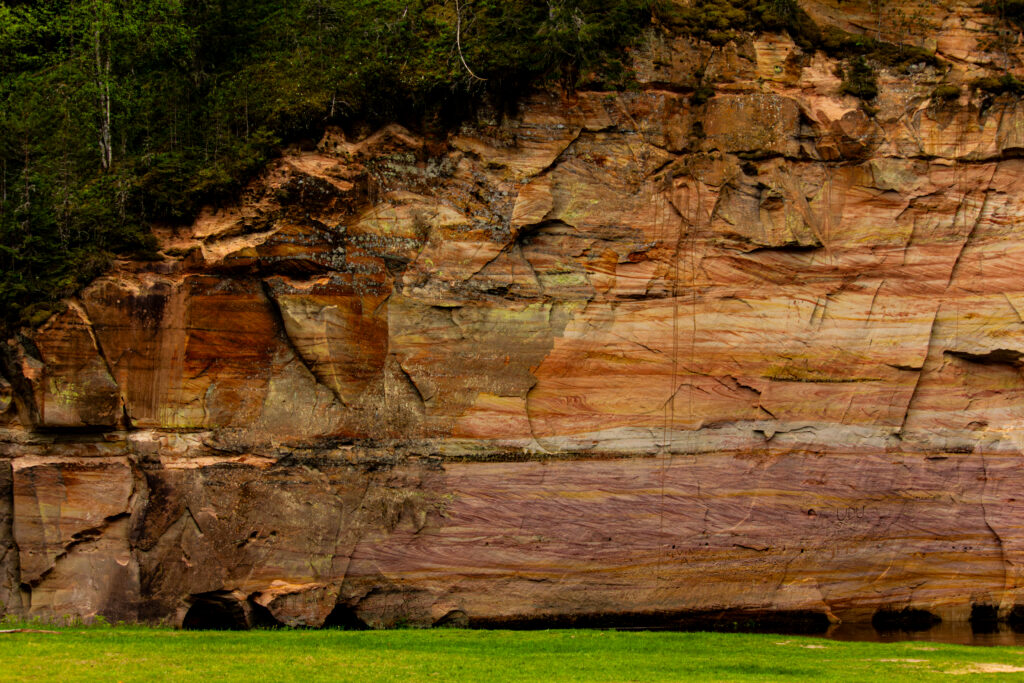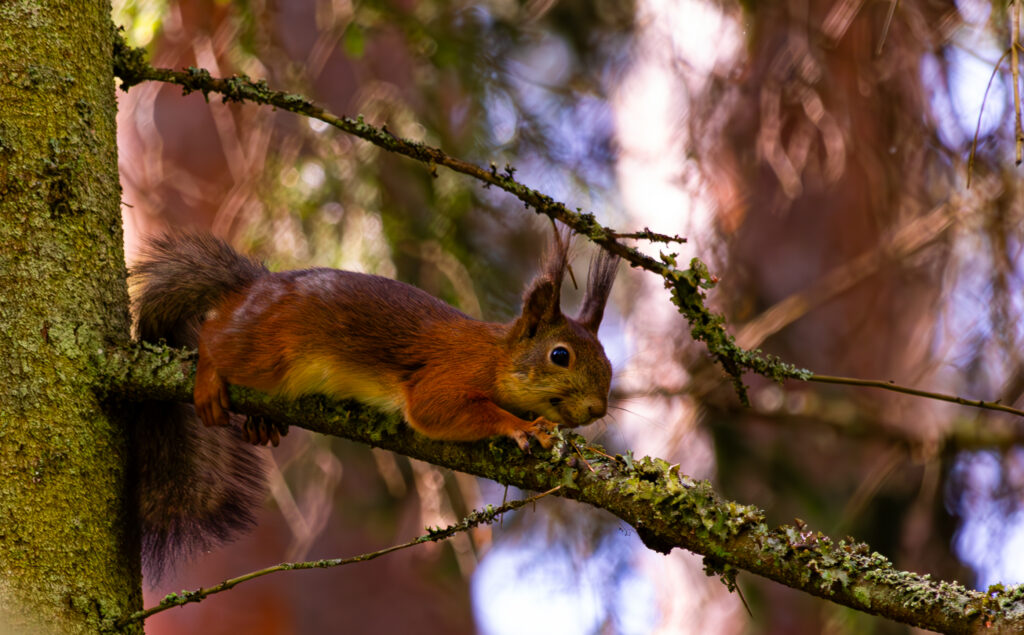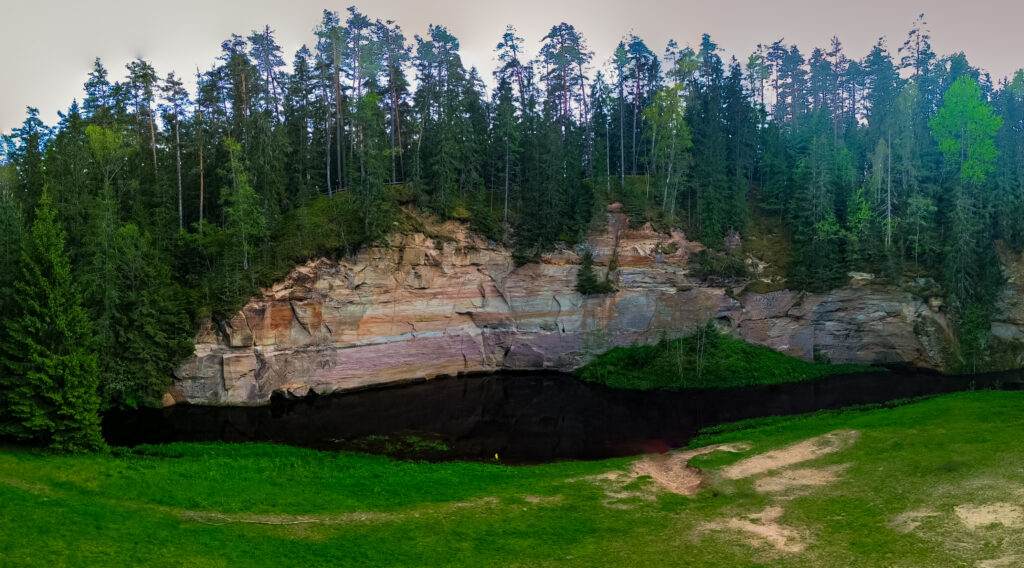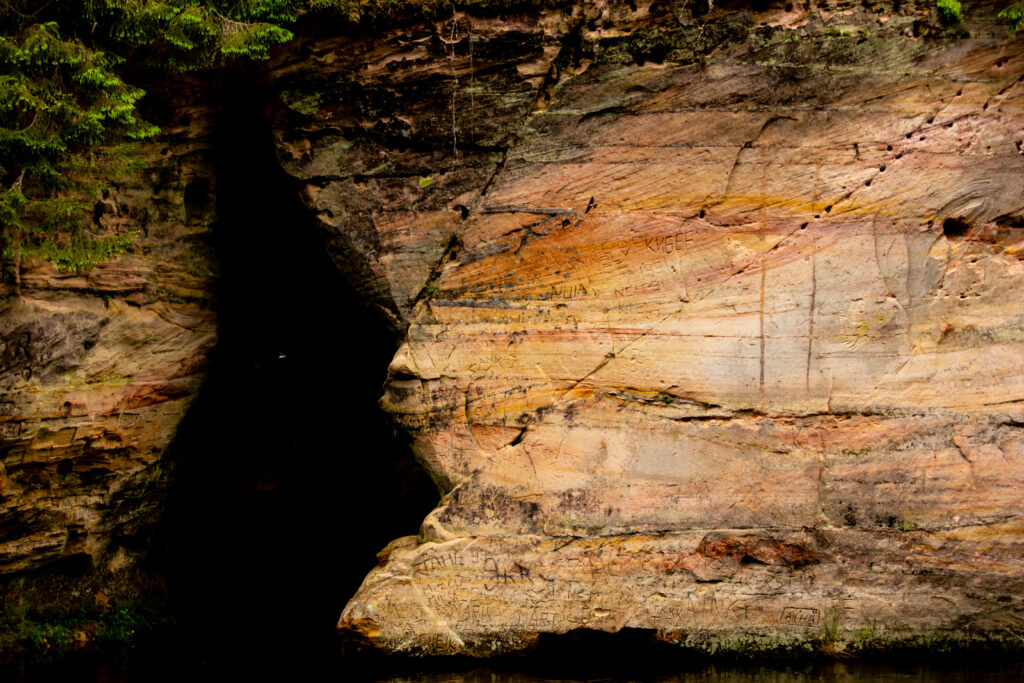I’ve visited Taevaskoda more times than I can count and yet every single visit feels like the first. There’s something timeless and grounding about this place, an almost sacred silence in the cliffs, the gentle flow of the Ahja River, the rustle of leaves in the breeze. Whether I go alone with my camera or walk the trail with a friend, Taevaskoda never fails to stop me in my tracks. It’s one of those rare places where time feels like it pauses and all that exists is nature, light, and presence.


Time in Stone and The Layers of Earth
Standing in front of the Suur Taevaskoda (Great Heaven’s Hall) is like looking into the past. The towering sandstone cliffs, formed over 360 million years ago during the Devonian period, are not just a backdrop—they’re a living history book carved by time itself. Each visible horizontal line in the rock tells a story of long-extinct riverbeds, ancient climates, and sediment laid down over countless millennia.
These layers are more than just geological formations. They are visual proof of time’s slow, methodical hand at work. You begin to notice subtle shifts in color and texture, from pale beige to rusty orange, each marking an environmental change that predates humanity by unimaginable scales. Sometimes, fossil imprints or erosion patterns offer small but powerful reminders that this entire region was once underwater, shaped by the flow of ancient seas.
Nature & Wildlife
The surrounding forest is pristine and peaceful, full of old pines and moss-covered stones. The air smells like damp earth and pine needles, and everything feels alive. Birds nest in the cliffs. Sand martins and swallows swoop overhead while woodpeckers tap in the background. Eurasian nuthatches scurry along tree trunks, and in the quiet of the forest paths, the chittering of red squirrels is a regular soundtrack. These little creatures dart through the underbrush or leap between branches, occasionally stopping just long enough for a quick photo if you’re patient.
But it’s not just about birds and squirrels. I’ve spotted fox tracks, heard the rustle of deer deeper in the woods, and in the dusk hours, bats flicker silently across the sky. The biodiversity here is subtle but rich, and as a photographer, it’s a dream to try and catch even a glimpse of it al


Myths and History
Taevaskoda is not just a geological or scenic treasure it is a spiritual and mythical landmark in the Estonian cultural landscape. For centuries, the sandstone cliffs, springs, and surrounding forests have been steeped in legends, stories, and sacred meaning passed down through generations.
One of the most enduring legends tells of giants who once roamed these cliffs. According to folklore, the name “Taevaskoda” (Heaven’s Hall) refers to the belief that the towering rock formations were built or shaped by supernatural beings. These giants are said to have carved out the cliffs and left behind deep footprints, which some locals claim can still be seen in certain rock formations. The massive scale and almost architectural appearance of the cliffs certainly fuel this myth it’s easy to imagine they were shaped by something greater than time alone.
Another sacred site in the area is the Emaläte or Mother Spring, a bubbling freshwater spring nestled in the forest near Suur Taevaskoda. Traditionally, people believed that the water had healing powers and that making wishes or offerings here could bring good fortune. Even today, visitors still pause in silence, cup their hands to drink, or toss coins into the clear pool. There’s a quiet reverence around the spring that feels deeply human and timeless.
The area was also thought to be a place of pagan worship before the spread of Christianity in Estonia. Some historians believe that Taevaskoda may have served as a natural temple where rituals and seasonal ceremonies were held. Its dramatic beauty and sense of isolation make it easy to imagine early Estonians gathering here under the stars, lighting fires, and offering prayers to the spirits of nature.
In more modern times, Taevaskoda gained national attention as one of the central filming locations for the beloved 1969 Estonian adventure film “Viimne reliikvia” (The Last Relic). The film, based on Eduard Bornhöhe’s historical novel, is deeply etched into the Estonian cultural consciousness. Scenes filmed at Suur Taevaskoda and the surrounding forest gave the location a kind of cinematic immortality, drawing fans of the film to walk the same trails and see the landscape that framed its most iconic moments.
This blend of ancient myth, natural spirituality, and cultural memory gives Taevaskoda a unique atmosphere. You don’t just see the landscape you feel it. Every sound echoing off the cliffs, every ripple in the water, carries the weight of stories both told and untold.

A Playground for the Creative Eye
From a photographer’s perspective, Taevaskoda is a treasure trove of compositions. The way the river curves, the reflections of the cliffs in the still water, the way light filters through the trees, all of it invites creative experimentation. I’ve taken wide-angle landscapes, focused macro shots of mushrooms and moss, long exposures of the river’s flow, and moody images during foggy mornings. It’s one of those rare places where every season and every hour of the day offers something new. And because time seems to move slower there, I often find myself lost in the moment behind the lens.
Seasons and Trails
Taevaskoda is a place that truly changes with the seasons, offering something special every time you visit. Whether it is your first time or your tenth, the landscape always seems to hold a new surprise.
In spring, the forest wakes up as the Ahja River runs fast and clear. Wildflowers bloom along the banks and birds return to the cliffs, making it a vibrant time for nature walks and wildlife photography.
Summer brings deep green forests and long golden evenings. The trails are more lively with visitors but it never feels crowded. The warm light on the sandstone cliffs is perfect for photographers and there is a peacefulness in the shaded paths that makes summer hikes truly relaxing.
Autumn is when Taevaskoda becomes magical. The forest turns into a tapestry of reds, oranges, and yellows which contrast beautifully with the cliff faces and river. It is the best time for photographers and hikers who enjoy crisp air and rich color.
Winter transforms the area into a serene snow covered wonderland. Fewer people visit, making it feel incredibly peaceful. Snow on the cliffs and frozen sections of river add a unique stillness, though the trails can be slippery and require care.
The most popular trail is a 3 to 5 kilometer loop starting at the Taevaskoja parking area. It passes both Suur and Väike Taevaskoda, alongside riverside paths and viewing platforms. The route is well marked and easy for most, with options to venture deeper into the Ahja River Valley for longer hikes or camping.
No matter the season, Taevaskoda is always worth the trip. Just bring the right shoes and your camera.


Protection and Preservation
As more people discover Taevaskoda, the challenge becomes preserving its unique beauty. The area is part of the Ahja River Valley Landscape Protection Area and conservation efforts are ongoing. That said, erosion of the sandstone, off-trail walking, and increased foot traffic do pose risks. I always encourage visitors to respect the marked trails, take their trash with them, and observe wildlife from a distance. The magic of Taevaskoda is in its purity. Let’s keep it that way for generations to come.
Final Thoughts
Taevaskoda has become one of the few places I return to not just for beauty but for clarity and calm. It has a grounding effect that I’ve rarely felt elsewhere. Whether you’re a hiker, a nature lover, a photographer, or someone simply looking to reconnect with something real, this place will speak to you
Pack your camera, lace up your boots, and come see where time stands still.
